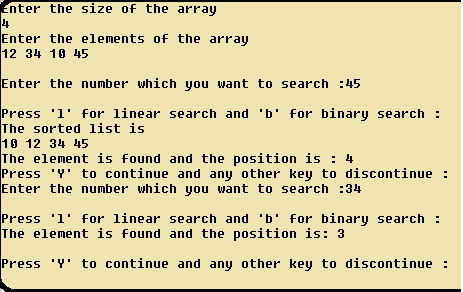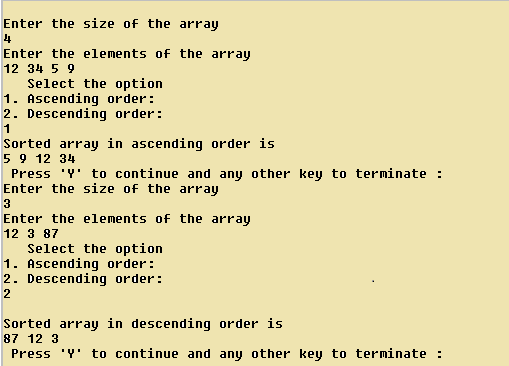Searching and Sorting
Searching:
Linear Search:
Binary Search:
Program to find an element m in an array a of n elements and print it's position in the array.
#include <conio.h>
void main( )
{
int m,i, n, j, temp, flg, low, middle, high, a[100];
char ch;
clrscr( );
flg=0;
printf("Enter the size of the array \n");
scanf("%d",&n);
printf("Enter the elements of the array \n");
for (i=1; i<=n;i++)
{
scanf("%d", &a[i]);
}
do
{
printf("\nEnter the number which you want to search :");
scanf("%d", &m);
printf ("\nPress 'l' for linear search and 'b' for binary search :");
ch=getch( );
switch(ch)
{
case 'l':
for (i=1; i<=n;i++)
{
if(a[i]==m)
{
flg=1;
break;
}
}
if(flg== 1)
{
printf("\nThe element is found and the position is: %d",i);
printf("\n");
}
else
printf("\nElement is not found \n");
break;
case 'b':
for (i=1; i<=n-1;i++)
{
for (j=i+1;j<=n;j++)
{
if(a[i]>a[j])
{
temp=a[i];
a[i]=a[j];
a[j]=temp;
}
}
}
printf("\nThe sorted list is \n");
for (i=1; i<=n;i++)
{
printf("%d ",a[i]);
}
low=1;
high=n;
while (low<=high)
{
middle=(low+high)/2;
if(a[middle] == m)
{
flg = 1;
break;
}
else
{
if(a[middle]<m)
{
low=middle+1;
}
else
{
high=middle-1;
}
}
}
if(flg == 1)
printf("\nThe element is found and the position is : %d", middle);
else
printf("\nThe element is not found \n");
break;
default:
printf("\nWrong selection \n");
break;
}
flushall();
printf("\nPress 'Y' to continue and any other key to discontinue : ");
ch=getch( );
}while (ch == 'Y');
getch( );
}
Output:

Note:
Sorting:
When the approach is used during the first pass the first and second element a[1] and a[2] are compared if they are out of order then the two elements are inter changed. This process is repeated for array of elements a[2] and a[3], a[3] and a[4] until a[n-1] and a[n].
This process causes elements with smaller values to bubble up the array and hence the name bubble sort. Thus after the 1st pass the largest element will be at the nth position and on each of the successive pass the element with next largest value will be placed in position n-1, n-2 ... so on. Where a is an array of n elements.
#include <stdio.h>
#include <conio.h>
void main( )
{
int i, j, temp, n, num, ar[100];
char ch;
clrscr( );
do
{
printf ("\nEnter the size of the array \n");
scanf ("%d", &n);
printf("Enter the elements of the array \n");
for (i=1; i<=n;i++)
{
scanf("%d", &ar[i]);
}
printf(" Select the option \n");
printf("1. Ascending order: \n");
printf("2. Descending order: \n");
scanf("%d",&num);
switch(num)
{
case 1:
for (i=1; i<=n-1;i++)
{
for (j=1; j<=n-i;j++)
{
if(ar[j]>ar[j+1])
{
temp=ar[j];
ar[j]=ar[j+1];
ar[j+1]=temp;
}
}
}
printf("Sorted array in ascending order is \n");
for (i=1; i<=n;i++)
{
printf("%d ",ar[i]);
}
break;
case 2:
for (i=1; i<=n-1;i++)
{
for (j=1; j<=n-i;j++)
{
if(ar[j]<ar[j+1])
{
temp=ar[j];
ar[j]=ar[j+1];
ar[j+1]=temp;
}
}
}
printf("\nSorted array in descending order is \n");
for (i=1; i<=n;i++)
{
printf("%d ",ar[i]);
}
break;
default:
printf("Wrong selection \n");
break;
}
printf("\n Press 'Y' to continue and any other key to terminate : ");
flushall( );
ch=getch( );
}while (ch == 'Y');
getch( );
}
Output:

Handling of Character Strings << Previous
Next >> User Defined Functions
Our aim is to provide information to the knowledge seekers.








